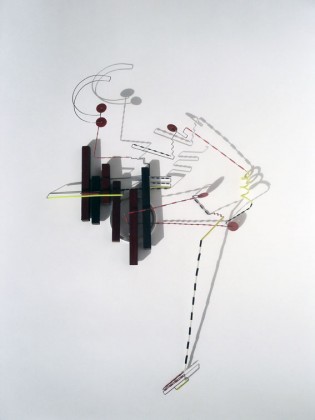



 |
 |
Français |  |
 |
English |


There is something new around Caroline Zelnik. A proposition somewhere between paleontology and holiday furniture.
Lounge chairs, tubing, sun-shades of various kinds, left in the barn awaiting the summer.
The artists’ hands have tinkered with them, added, deviated, decorated; and here they are, plumed with all the amused elegance with which Caroline Zelnik faces the world... Creatures from the Cenozoic era have settled... An Archaeopteryx has lingered here.
Thanks to Zelnik, a world now stands ready, ready to come into play. Readiness is all, I was saying, quoting Shakespeare, because I feel that her constructions are as if awaiting a departure. As if on starting-blocks. Almost all oriented in one direction. Aimed. One paw raised. Necks straight and tense. That’s it. Awake and focused. A gift for Darwin, all these specimens on the point of coming back to life. He’s ringed them, to be sure of finding them again when they’re out in the wild. Carried off by those who have seen the joyous movement, always rhythmic, of their light mechanisms. There are rings, wedding rings dancing in these new marriages. Brides, naked... juggling. We think of tight-rope walkers, of the circus where the rings fly into the air and come down always in the right place, like boomerangs. “Boomerang”, a word resonating with Caroline Zelnik’s objects. A random movement but with an inner logic. Something that stands upright, it’s balanced, but as if on trapezes that she has slightly, wickedly made just a little too thin.
All this stuff, as a whole conveys the sense of Zelnik’s gravity... but also a touch of vertigo. Balance is maintained, a joyful energy; but also evoking risk, the possibility of falling.
Through her whimsical compositions we come to understand that from an unstable equilibrium it is possible to attain the harmony we seek.
Muriel Teodori

 Assembling, a beautiful mission (2006)
Assembling, a beautiful mission (2006)


Women bending, Harlequins, children dancing, people sleeping, Utopias, it is a world full of benevolence that we are offered here by Caroline Zelnik.
At the core of her artistic gesture, there is the idea of assembling, a word which implies a wish to see things reconciled.
Small bits fixed up, small derisory, abandoned components reminding us of their belonging to the great whole in which nothing can be without importance. The artist patiently collected all these remains of former stories, all these fragments, and then she got to work.
Motivated by this simple mission to organize a reunion, she decided to trustfully assemble disparate elements and with these hybrid components to create a harmonious whole.
A « mixed technique », she calls it when she invents this dragonfly-ship, a condensed mythical animal, as if repaired and ready for another chance of taking a flight.
A « mixed technique » used to mix the densest materials with the lightest ones and evoke lightness, translucence, elegance, poetry, as if she were playfully stopping the flight of some ephemeral insect for a moment.
There is mischievousness in Caroline Zelnik's art, the discreet power to create a world to her liking, upside down, the earth in the sky, a zany-looking reality full of humour and of colours reminiscent of the Bauhaus style.
The weight? The size? That's a surprise! Her assembled creations have but one dimension: something of a balance between gravity and weirdness.
There is an amused tenderness in her way to do away with spatial landmarks. A small cosmogony. A big wooden horse. Boats that could be held in the hand. The large dragonfly. And everywhere the rhythm of a more or less provoked motion.
What is presented to us is a musical space: a note of wood, the chord of thin metallic wires, a scale of polished glass pieces, scores of cardboard to which this handywoman, a cousin of Satie's in her liking for simple things, gives coherence without taking things seriously.
Is it possible to say about an exhibition that you must go and hear it? At the gallery Weiller, however, there is at present a world stirring in the slightest wind. Something evoking a Faraday cage, the passage of electricity, Dzung, Bzz, like the onomatopoeic suspension of free and whispering electrons.
When we were children, we used to draw with our fingers forms in the air to be recognized.
Caroline Zelnik knows how to give these forms back to us, and this for a longer while.
Muriel Teodori




Muriel Téodori




Jean Gibiard



Sabine Melchior-Bonnet


